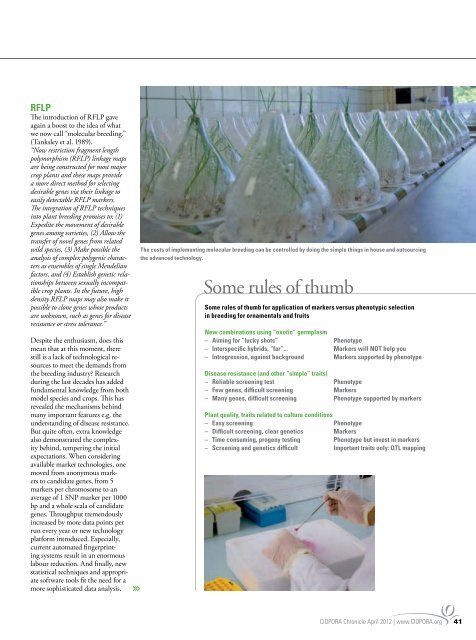2012 CIOPORA Chronicle
CIOPORA annual magazine on Intellectual Property protection for plant innovations 2012. The magazine was produced in cooperation with FloraCulture International. Read in the 2012 CIOPORA Chronicle edition: - Plant Patents in the United States after the America Invents Act - U.S. plant patents compared to UPOV PBR system - Does Belgian patent law need a breeder’s exemption? - How much open access can breeders afford? - IPP and PBR in Chile - IP protection for plant innovations in Canada and much more...
CIOPORA annual magazine on Intellectual Property protection for plant innovations 2012. The magazine was produced in cooperation with FloraCulture International.
Read in the 2012 CIOPORA Chronicle edition:
- Plant Patents in the United States after the America Invents Act
- U.S. plant patents compared to UPOV PBR system
- Does Belgian patent law need a breeder’s exemption?
- How much open access can breeders afford?
- IPP and PBR in Chile
- IP protection for plant innovations in Canada
and much more...
You also want an ePaper? Increase the reach of your titles
YUMPU automatically turns print PDFs into web optimized ePapers that Google loves.
RFLP<br />
The introduction of RFLP gave<br />
again a boost to the idea of what<br />
we now call “molecular breeding.”<br />
(Tanksley et al. 1989).<br />
“Now restriction fragment length<br />
polymorphism (RFLP) linkage maps<br />
are being constructed for most major<br />
crop plants and these maps provide<br />
a more direct method for selecting<br />
desirable genes via their linkage to<br />
easily detectable RFLP markers.<br />
The integration of RFLP techniques<br />
into plant breeding promises to: (1)<br />
Expedite the movement of desirable<br />
genes among varieties, (2) Allow the<br />
transfer of novel genes from related<br />
wild species, (3) Make possible the<br />
analysis of complex polygenic characters<br />
as ensembles of single Mendelian<br />
factors, and (4) Establish genetic relationships<br />
between sexually incompatible<br />
crop plants. In the future, high<br />
density RFLP maps may also make it<br />
possible to clone genes whose products<br />
are unknown, such as genes for disease<br />
resistance or stress tolerance.”<br />
Despite the enthusiasm, does this<br />
mean that at this moment, there<br />
still is a lack of technological resources<br />
to meet the demands from<br />
the breeding industry? Research<br />
during the last decades has added<br />
fundamental knowledge from both<br />
model species and crops. This has<br />
revealed the mechanisms behind<br />
many important features e.g. the<br />
understanding of disease resistance.<br />
But quite often, extra knowledge<br />
also demonstrated the complexity<br />
behind, tempering the initial<br />
expectations. When considering<br />
available marker technologies, one<br />
moved from anonymous markers<br />
to candidate genes, from 5<br />
markers per chromosome to an<br />
average of 1 SNP marker per 1000<br />
bp and a whole scala of candidate<br />
genes. Throughput tremendously<br />
increased by more data points per<br />
run every year or new technology<br />
platform introduced. Especially,<br />
current automated fingerprinting<br />
systems result in an enormous<br />
labour reduction. And finally, new<br />
statistical techniques and appropriate<br />
software tools fit the need for a<br />
more sophisticated data analysis.<br />
>>><br />
The costs of implementing molecular breeding can be controlled by doing the simple things in house and outsourcing<br />
the advanced technology.<br />
Some rules of thumb<br />
Some rules of thumb for application of markers versus phenotypic selection<br />
in breeding for ornamentals and fruits<br />
New combinations using “exotic” germplasm<br />
– Aiming for “lucky shots” Phenotype<br />
– Interspecific hybrids, “far”... Markers will NOT help you<br />
– Introgression, against background Markers supported by phenotype<br />
Disease resistance (and other “simple” traits)<br />
– Reliable screening test Phenotype<br />
– Few genes, difficult screening Markers<br />
– Many genes, difficult screening Phenotype supported by markers<br />
Plant quality, traits related to culture conditions<br />
– Easy screening Phenotype<br />
– Difficult screening, clear genetics Markers<br />
– Time consuming, progeny testing Phenotype but invest in markers<br />
– Screening and genetics difficult Important traits only: QTL mapping<br />
<strong>CIOPORA</strong> <strong>Chronicle</strong> April <strong>2012</strong> | www.<strong>CIOPORA</strong>.org 41









